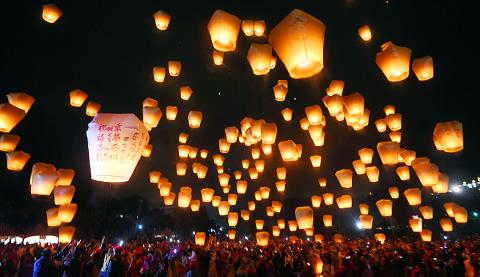The international honors for the Pingsi Sky Lantern Festival continue to pile on — just recently, it was named one of National Geographic’s top 10 winter trips for this year.
Meanwhile in Taiwan, the festival continues to expand and become more elaborate. Despite the expected massive crowds and the excruciatingly long waiting times for buses to get there and back (cars are not allowed during festival times), the sight of hundreds of brightly colored lanterns rising into the sky in unison is something worth seeing at least once.
This year, the official festivities take place on Feb. 11, Feb. 14 and Feb. 22, with an estimated total of 3,280 lanterns to be set off into the sky over eight separate waves per event. Musical performances are held between each wave.

Photo courtesy of Wikimedia Commons
Registration to take place in the mass lantern set off begins at 10:30am each day, but you can also buy your own lanterns at local stores — as long as you only set them off between 6am and 10pm in designated areas.
Remember to write your wishes on the lantern — the lanterns were used for communication purposes in mountainous terrain during the late 1800s, but now they’re used to pray for better luck.
The first event has a children’s theme — and the main 2.4m-wide lantern is created by illustrator Crystal Hung (克里斯多, real name Hung Ya-yan, 洪佳妍) using 3,000 fingerprints of both adults and children collected during an earlier Christmas event. A total of 480 lanterns will be set off during this event — less than half of that for the next two events, so choose wisely.
The Feb. 14 event is of course Valentine’s Day-themed, featuring 200 lanterns with lovers’ fingerprints on them and 1,200 regular ones. Feb. 22 features 1,600 lanterns, with the 4.8m-wide main one created using photos from 53 countries that 6-year-old girl Ching Ching (晴晴), whose dream is to travel the world, collected via Facebook.
Aside from the lantern festival, the area’s old mining communities of Jingtong (菁桐), Pingsi and Shihfen (十分) are well worth visiting with picturesque old streets and several walking paths. Also nearby is the Shihfen Waterfall, which re-opened to the public in December 2014.
If you happen to see any sky lantern debris during your explorations, take them back to the three designated shops in town for recycling and receive store credit in exchange. Don’t leave them there, it’s bad for the environment.

Nine Taiwanese nervously stand on an observation platform at Tokyo’s Haneda International Airport. It’s 9:20am on March 27, 1968, and they are awaiting the arrival of Liu Wen-ching (柳文卿), who is about to be deported back to Taiwan where he faces possible execution for his independence activities. As he is removed from a minibus, a tenth activist, Dai Tian-chao (戴天昭), jumps out of his hiding place and attacks the immigration officials — the nine other activists in tow — while urging Liu to make a run for it. But he’s pinned to the ground. Amid the commotion, Liu tries to

A dozen excited 10-year-olds are bouncing in their chairs. The small classroom’s walls are lined with racks of wetsuits and water equipment, and decorated with posters of turtles. But the students’ eyes are trained on their teacher, Tseng Ching-ming, describing the currents and sea conditions at nearby Banana Bay, where they’ll soon be going. “Today you have one mission: to take off your equipment and float in the water,” he says. Some of the kids grin, nervously. They don’t know it, but the students from Kenting-Eluan elementary school on Taiwan’s southernmost point, are rare among their peers and predecessors. Despite most of

A pig’s head sits atop a shelf, tufts of blonde hair sprouting from its taut scalp. Opposite, its chalky, wrinkled heart glows red in a bubbling vat of liquid, locks of thick dark hair and teeth scattered below. A giant screen shows the pig draped in a hospital gown. Is it dead? A surgeon inserts human teeth implants, then hair implants — beautifying the horrifyingly human-like animal. Chang Chen-shen (張辰申) calls Incarnation Project: Deviation Lovers “a satirical self-criticism, a critique on the fact that throughout our lives we’ve been instilled with ideas and things that don’t belong to us.” Chang

Feb. 10 to Feb. 16 More than three decades after penning the iconic High Green Mountains (高山青), a frail Teng Yu-ping (鄧禹平) finally visited the verdant peaks and blue streams of Alishan described in the lyrics. Often mistaken as an indigenous folk song, it was actually created in 1949 by Chinese filmmakers while shooting a scene for the movie Happenings in Alishan (阿里山風雲) in Taipei’s Beitou District (北投), recounts director Chang Ying (張英) in the 1999 book, Chang Ying’s Contributions to Taiwanese Cinema and Theater (打鑼三響包得行: 張英對台灣影劇的貢獻). The team was meant to return to China after filming, but